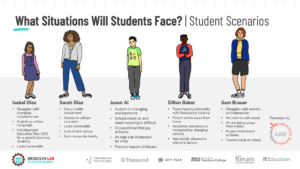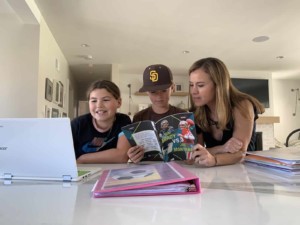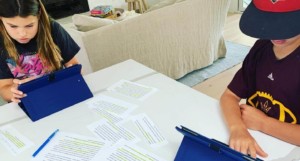Combining Inquiry and PBL: 3 Guidelines for Success

By Kelsey Bednar
High-Quality Project-Based Learning (PBL) provides opportunities for sustained inquiry over multiple working sessions. Transitioning to PBL involves shifts in planning, instruction, classroom management and teacher-student interaction.
In my experience supporting educators who are making this shift, I hear one challenge voiced more consistently than others: how do I facilitate student inquiry?
Sustained Inquiry is one of the Essential Project Design Elements of PBL developed by the Buck Institute for Education (BIE). BIE defines sustained inquiry as a time where “Students engage in a rigorous, extended process of asking questions, finding resources, and applying information.” To successfully facilitate this element of the PBL experience, teachers should consider these 3 things:
Plan Flexibly
Just like planning for a more traditional unit of study, in PBL units we must begin with the end in mind (similar to the ideas brought forth in Understanding by Design). Identifying important student outcomes related to content and skills is the first step. From this point, think about PBL unit planning like a jigsaw puzzle. The pieces of the puzzle are instructional activities that support the development of content and skill understandings such as mini-lessons, readings, experiments, videos, field work etc. All of these pieces eventually connect to form a whole, which in this analogy equates to the achievement of student learning outcomes.
However, in a PBL unit you do not plan to use these pieces in a set sequence like you might in a traditional unit of study. You plan to use them flexibly, knowing that some of them may not even be necessary once you dive into the project. Based upon student questions and the direction their inquiry takes throughout the project, you can pull in different instructional pieces at different times to support and address student questions.
Help Students Develop Good Questions
A successful PBL unit begins with a good introductory activity. It may be asking the students a driving question, having them follow a GRASPS template, or discussing a phenomenon that students experience. What comes after the introduction of a unit is equally important, but often more challenging: helping students develop good questions that will drive sustained inquiry.
In my experience, teachers who excel in supporting student inquiry set aside sufficient time right after the unit intro for developing questions. These questions then support the learning shaped by the task and the eventual project outcome. One strategy I recommend to teachers who are new to this process is to use the Question Formulation Technique, which is a 5 step process that can be used with students of any age. It helps produce thought-provoking, meaningful questions that enhance a specific PBL unit and it teaches students how to develop, revise and prioritize questions in any situation.
Remember that Inquiry is Not Research
Engaging in inquiry does not mean logging hours in the library or on the computer searching for information. Especially with elementary students, inquiry happens in a variety of settings and experiences. As John Larmer, Editor in Chief of the Buck Institute, points out: “Students can find answers to their questions from many sources, including readings, but also experts, experiments, and field work.”
One good example of this is a real-world PBL experience that was conducted by a sixth-grade class during a summer STEM program at Weedsport Elementary. The goal of the 4-week long project was for the students to develop a low-fat, cost-effective ice cream and persuade a mock school board to add this ice cream to the school cafeteria menu.
The questions students brainstormed at the outset of this ice-cream project launched the inquiry process that deepened and extended their learning, allowing them to accomplish the goal of the task. Inquiry-encouraging activities that a teacher might incorporate at various stages of this project could include:
- Collecting, organizing, and displaying data on preferred flavors of current ice creams.
- Mini-lessons and/or non-fiction readings about protein, sugar, fat and their effects on the body.
- Looking at ice cream commercials and advertisements and making observations about what makes for an effective ad.
- Researching ice cream recipes to understand what ingredients are typically used.
- Experimenting with different ingredients in an ice-cream maker to determine what could replace existing ingredients or be added to existing ingredients to make a healthier version of ice cream.
(This project was based on an idea from Defined STEM (the company I work for), a project-based learning resource that provides hundreds of projects centered on real-world problems and challenges.)
Facilitating inquiry does not have to be an obstacle to the successful implementation of PBL in your classroom. Following these three guidelines can help you organize, plan and facilitate flexibly- creating a great experience for both you and your students.
For more on inquiry, see:
- 5 Low Tech Ways to Hone Inquiry and Questioning Skills
- The Innovation to Drive Innovation: Scaling Inquiry
- 9 Simple Steps that Encourage Inquiry-Based Learning in Science
Kelsey Bednar is a Curriculum Manager and National Trainer at Defined Learning. Follow her on Twitter: @kdbednar
Stay in-the-know with all things EdTech and innovations in learning by signing up to receive the weekly Smart Update. This post includes mentions of a Getting Smart partner. For a full list of partners, affiliate organizations and all other disclosures, please see our Partner page.







Thom Markham
As PBL grows in popularity, it is increasingly necessary to distinguish 'PBL-lite' from 'PBL-deep'. A series of inquiry activities strung together without a defined, complex Driving Question will not force depth of thinking and critical choice-making, or help identify the authentic task. One possibility in this case: 'How can we, as a marketing team, use cost, taste, and nutritional arguments to convince local schools to use our ice cream products in school cafeterias?'
Kay Oddone
I agree with the majority of this article, however take issue with the heading "Remember that Inquiry is Not Research." Perhaps a more accurate heading would be "Remember that Inquiry is not *traditional* research." Everything described in the paragraph to me reflects what good research is - creating new knowledge by searching for data and information and combining in in ways that respond to the inquiry question. I believe that a narrow view of what research involves may be one of the reasons students struggle to be critically literate - they know that they have to check the validity of a source when conducting traditional research (which is great) but they don't necessarily transfer this awareness to other types of research, including evaluating images and graphical data, examining for bias in primary sources or checking the reliability of tools used to capture data. We life in an information saturated world, where research extends far beyond what can be gathered from texts in the form of notes. This is why we need teacher librarians - experts in critical literacy and information literacy - to reinforce and model contemporary research, which definitely includes traditional techniques, but also transcends multimodal, digital and physical sources.